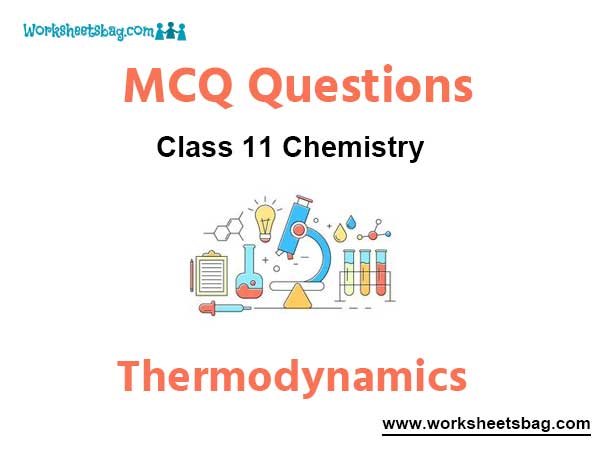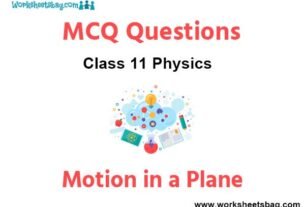Please refer to Thermodynamics MCQ Questions Class 11 Chemistry below. These MCQ questions for Class 11 Chemistry with answers have been designed as per the latest NCERT, CBSE books, and syllabus issued for the current academic year. These objective questions for Thermodynamics will help you to prepare for the exams and get more marks.
Thermodynamics MCQ Questions Class 11 Chemistry
Please see solved MCQ Questions for Thermodynamics in Class 11 Chemistry. All questions and answers have been prepared by expert faculty of standard 11 based on the latest examination guidelines.
MCQ Questions Class 11 Chemistry Thermodynamics
Question. The succeeding operations that enable this transformation of states are
(a) heating, cooling, heating, cooling
(b) cooling, heating, cooling, heating
(c) heating, cooling, cooling, heating
(d) cooling, heating, heating, cooling
Answer
C
Question. A gas expands from a volume of 1m3 to a volume of 2m3 against an external pressure of 105 Nm-2 . The work done by the gas will be
(a) 102 kJ
(b) 102 J
(c) 103 J
(d) 105 kJ
Answer
A
Question. A gas undergoes a thermodynamical process but the volume of the gas does not change. What is the nature of this process ?
(a) Isothermal
(b) Adiabatic
(c) Isobaric
(d) Isochoric
Answer
D
Question. An ideal gas expands in volume from 1 x 10-3 m3 to 1 x 10-2 m3 at 300 K against a constant pressure of 1 x 105 Nm-2 . The work done is
(a) – 9001
(b) – 900kJ
(c) 270kJ
(d) 900kJ
Answer
A
Question. An adiabatic process occurs in
(a) open system
(b) closed system
(c) isolated system
(d) in all the given system
Answer
C
Question. Which one of the following is an exothermic reaction?
(a) N2 (g) + O2 (g )+ 180. 8kJ → 2NO(g)
(b) N2 (g)+ 3H2 (g) – 92kJ → 2NH3 (g)
(c) C(g) + H2O(g) → CO(g) + H2 (g) – 131.1 kJ
(d) C(graphite)+2S(s) → CS2(l) – 91.9 kJ
Answer
B
Question. At 25°C, for the combustion of 1 mole of liquid benzene, the heat ofreaction at constant pressure is given by C6H6 (/) +15/2 O2 (g) → 6CO2 (g)+ 3H2O (/),
(ΔH = 780980cal)
Calculate the heat of reaction at constant volume
(a) 780.086 kcal
(b) – 780.086 kcal
(c) – 390.043 kcal
(d) 390.043 kcal
Answer
A
Question. A piston filled with 0.04 mole of an ideal gas expands reversibly from 50.0 mL to 375 mL at a constant temperature of 37.0°C. As it does so, it absorbs 208 J of heat. The values of q and W for the process will be (R = 8.314 J/mol K, In 7.5 = 2.01)
(a) q = + 208 J, W = – 208 J
(b) q = – 208 J, W = – 208 J
(c) q = – 208 J, W = + 208 J
(d) q = + 208 J, W = + 208 J
Answer
A
Question. IfC (s)+ O2(g) → CO2 (g);ΔH = r and l CO (g)+ 1/2 O2 → CO2 (g); ΔH =s, then the heat of 2 formation of CO is
(a) r+s
(b) r – s
(c) s – r
(d) rs
Answer
B
Question. C(s) + O2 (g) → CO2(g); ΔH = –94kcal
2CO(g) + O2 → 2CO2 (g); ΔH = –135.2 kcal
The heat of formation of CO (g) is
(a) – 26.4 kcal
(b) 41.2 kcal
(c) 26.4 kcal
(d) 229.2 kcal
Answer
A
Question. Internal energy is sum of
(a) kinetic energy and potential energy
(b) all types of energy of the system
(c) energy of internal system
(d) None of the above
Answer
B
Question. At 27° C one mole of an ideal gas is compressed isothermally and reversible from a pressure of 2 attn to 10 attn. The value of ΔE and q are ( R = 2 cal)
(a) 0, –965.84cal
(b) –965.84cal, –865.58cal
(c) + 865.58cal, –865.58cal
(d) +965.84cal, + 865.58cal
Answer
A
Question. Hess’s law is based on
(a) law of conservation of mass
(b) law of conservation of energy
(c) first law ofthem1odynamics
(d) None of the above
Answer
B
Question. The internal energy changes when a system goes from state A to B is 40 kJ/mol. If the system goes from A to B by a reversible path and returns to state A by an i.tTeversible path, what would be the net change in internal energy ?
(a) 40 kJ
(b) > 40 kJ
(c) < 40 kJ
(d) Zero
Answer
D
Question. Mark out the enthalpy of formation of carbon monoxide (CO)
Given, C(s) + 1/2 O2 (g) → CO(g),
ΔH = – 39.3 kJ/rnol
CO(g) + 1/2 O2 (g) → CO2 (g), ΔH = –282.8 kJ/ mol
(a) 110.5 kJ/mol
(b) 676.1 kJ/mol
(c) 282.8 kJ/mol
(d) 300.0 kJ/mol
Answer
A
Question. In an adiabatic process
(a) p.ΔV = 0
(b) q =+W
(c) ΔE = q
(d) q = 0
Answer
D
Question. A plot of In k against 1/T (abscissa) is expected to be a straight line with intercept on coordinate axis equal to
(a) ΔS°/2.303R
(b) ΔS°/RE
(c) -ΔS°/R
(d) R x ΔS°
Answer
B
Question. A container of 1.0 L capacity filled with 1.0 mole of ideal gas is connected to an evacuated vessel of 9.0 L. Calculate change in entropy. (R = l.987 cal)
(a) 0.188cal. K-1 mol-1
(b) 0.4576cal.K-1 mol-1
(c) 4.576cal. K-1 mol-1
(d) 4.366cal. K-1 mol-1
Answer
D
Question. If t.Gfor a reaction is negative, you infer that the change is
(a) spontaneous
(b) non-spontaneous
(c) reversible
(d) irrevrsible
(e) equilibrium
Answer
A
Question. Using the data provided, calculate the multiple bond energy (kJ mol-1 )of a C = Cbond C2H2 . The energy is
(take the bond energy of a C—H bond as 350 kJ mol-1)
2C (s)+ H2 (g) → C2H2 (g); ΔH = 225 kJ mol-1
2C(s) → 2C(g); ΔH = 1410 kJ mol-1
H2 (g) → 2H(g); ΔH= 330 kJ mol-1
(a) 1165
(b) 837
(c) 865
(d) 815
Answer
D
Question. The Gibbs energy for the decomposition of Al2O3 at 500°C is as follows
2/3 Al2O3 ➔ 4/3 Al +O2 , ΔrG° = + 966 kJ mol-1
The potential difference needed for electrolytic reduction of Al2O3 at 500°C is at least
(a) 4.5 V
(b) 3.0 V
(c) 2.5 V
(d) 5.0 V
Answer
C
Question. Identify the correct statement from the following in a chemical reaction.
(a) The entropy always increases
(b) The change in entropy along with suitable change in enthalpy decides the rate of reaction
(c) The enthalpy always decreases
(d) Both the enthalpy and the entropy remain constant
Answer
D
Question. For an isolated system, ΔU = 0, then
(a) ΔS = 0
(b) ΔS <0
(c) ΔS > 0
(d) The values of ΔS cannot be predicted
Answer
C
Question. For the reaction at 298 K
A(g) + B(g) ⇌ C(g) + D(g)
ΔH° = – 29.8 kcal, ΔS° = – 0.100 kcal K-1
What is the value of ΔG° ?
(a) l
(b) 0
(c) 2
(d) 4
Answer
B
Question. During which phenomenon does entropy decrease ?
(a) Crystallisation of sucrose from its solution
(b) Melting of ice
(c) Sublimation of camphor
(d) Rusting of iron
Answer
A
Question. Among the following for spontaneity of chemical reaction there should be
(a) decrease in entropy and increase in free energy
(b) decrease in entropy and free energy both
(c) increase in entropy and decrease in free energy
(d) increase in entropy and free energy both
Answer
C
Question. The incorrect expression an1ong the following is t.G
(a) ΔGsystem / ΔSsystem= – T
(b) In 1sotherrmal process, Wreversible = – nRT ln Vf/vi
(c) In K = ΔG° – TΔS / RT
(d) K = e –ΔG°/RT
Answer
C
Question. Which of the following reactions define ΔG°f ?
(a) C(diamond) + O2 (g) → CO2 (g)
(b) 1/2 H2(g)+ 1/2 F2(g) → HF(g)
(c) H4P2O7 + H2O → 2H3PO4
(d) SO2 (g) + 1/2 O2 (g) → SO3 (g)
Answer
B
Question. If ΔG is negative, the reaction will be
(a) at equilibrium
(b) not possible
(c) Both (a) and (b)
(d) possible
Answer
D
Question. Which of the following processes is associated with decrease in entropy ?
(a) Vaporisation ofa mole of water into steam at its b.p.
(b) Dissociation of a mole of common salt in water at 300K
(c) Mixing of two partially miscible liquids
(d) Crystallisation of a salt from its saturated solution
Answer
D
Question. For a particular reversible reaction at temperature T, /ΔH and ΔS were found to be both +ve. lfTe is the temperature at equilibrium, the reaction would be spontaneous when
(a) Te > T
(b) T > Te
(c) Te is 5 times T
(d) T = Te
Answer
B
Question. A gas expands isothermally against a constant external pressure of 1 atm from a volume of 10 dm3 to a volwne of 20 dm3 . It absorbs 800 J of thermal energy from its surroundings. The ΔU is
(a) –3121
(b) +123J
(c) –213 J
(d) + 231 J
Answer
C
Question. An ideal gas is allowed to expand both reversibly and ineversibly in an isolated system. If Ti is the mitial temperatw·e and Tf is the final temperature, which of the following statements is correct ?
(a) (Tf)irrev > (Tf)rev
(b) Tf > Ti for reversible process but Tf = Ti for irreversible process
(c) (Tf)rev = (Tf) irrev
(d) Tf = Ti for both reversible and irreversible processes
Answer
A
Question. A hypothetical reaction A ➔ 2B, proceeds through following sequence of steps
(i) A → C; ΔH = q
(ii) C → D; ΔH = V
(iii) 1/2 D → B; ΔH = x
Then, the heat of reaction is
(a) q – v + 2x
(b) q + v – 2x
(c) q + v + 2x
(d) q + 2v – 2x
Answer
C
Question. In a closed contamer, a liquid is stirred with a paddle to increase the temperature. Which of the following is true?
(a) ΔE = W ≠ 0,q = 0
(b) ΔE = W = q ≠ 0
(c) ΔE = 0, W = q ≠ 0
(d) W = 0, ΔE = q ≠ 0
Answer
A
Question. Two moles of helium gas expanded isothermally and irreversible at 27°C fom1 volume 1 dm3 to 1 m3 at constant pressure of 100 k Pa. Calculate the work done.
(a) 99900 kJ
(b) 99900 J
(c) 35464.65 kJ
(d) 34465.65 J
Answer
B
Question. When one mole of monoatomic ideal gas at TK undergoes adiabatic change under a constant external pressure of 1 atm changes volume from 1 L to 2 L. The final temperature in Kelvin would be
(a) T/22/3
(b) T + 2/3x 0.0821
(c) T
(d) T + 2/3 X 0.082
Answer
A
Question. When two moles of hydrogen expands isothem1aJly against a constant pressure of 1 atm, at 25° C from 15 L to 50 L, the work done (in litre atrn) will be
(a) 17.5
(b) 35
(c) 51.5
(d) 70
Answer
B
Question. For the complete combustion of ethanol, C2H5OH (/) + 3O2 (g) → 2CO2 (g) + 3H2O(/) the amount of beat produced as measured in bomb calorimeter, is 1364.4 7 kJ mol-1 at 25°C. Assuming ideality the enthalpy of combustion, ΔHc, for the reaction will be (R = 8.314JK-1 mol-1)
(a) -1366.95 kJ mol-1
(b) -1361.95 kJ mol-1
(c) -1460.50 kJ mol-1
(d) – 1350.50 kJ mol-1
Answer
A
Question. The heat of combustion of sucrose, C12H22O11 (s) at constant volume is 1348.9 kcal mol-1 at 25°C, then the heat of reaction at constant pressure when steam is produced
(a) – 1348.9 kcal
(b) -1342.34 kcal
(c) + 1250 kcal
(d) None of the above
Answer
B
Question. The standard molar beat of formation of ethane, CO2 and water (l) are respectively – 21 .1, – 94.1 and – 68.3 kcal. The standard molar heat of combustion of ethane will be
(a) – 372 kcal
(b) 162 kcal
(c) – 240 kcal
(d) 183.5 kcal
Answer
A
Question. The ratio of heats liberated at 298 K from the combustion of one kg of coke and by burning water gas obtained from 1 kg of coke is (Assume coke to be 100% carbon). (Given : enthalpies of combustion of C, CO and H2 as 393.5 kJ, 285 kJ, 285 kJ respectively all at 298 K)
(a) 0.79: 1
(b) 0.69: 1
(c) 0.86: 1
(d) 0.96: 1
Answer
B
Question. In order to decompose 9 g water 142.5 kJ heat is required. Hence, the enthalpy of fom1ation of water is
(a) –142.5 kJ
(b) + 142.5 kJ
(c) –285 kJ
(d) + 285 kJ
Answer
C
Question. The enthalpy of combustion of C6H6 (/) is – 3250 kJ. When 0.39 g of benzene is burnt in excess of oxygen in an open vessel, the amount of heat liberated is
(a) 16.25 J
(b) 16.25 kJ
(c) 32.5 J
(d) 32.5 kJ
Answer
B
Question. A coffee cup calorimeter initially contains 125 g of water at a temperature of 24.2°C. After adding 10.5 g of KBr, the temperature becomes 21.1°C. The heat of solution is
(a) 40 J/g
(b) 117 J/g
(c) 167.7 J/g
(d) 420.05 J/g
Answer
C
Question. Given, that,
H2O(/) → H+ (aq)+ OH– (aq); ΔH = 57.32 kJ
H2 (g) + 1/2O2 (g) → H2 O(/); ΔH = –286.02 kJ
Then, calculate the enthalpy of fonnation of OH- at 25°C.
(a) –228.8 kJ
(b) –343.53 kJ
(c) + 228.8 kJ
(d) + 343.52 kJ
Answer
A
Question. Calculate the amount of heat evolved when 500cm3 of 0.1 M HCl ismixed with 200cm3 of 0.2 MNaOH.
(a) 57.3 kJ
(b) 2.865 kJ
(c) 2.292 kJ
(d) 0.573 kJ
Answer
C
Question. A sample of liquid in a thermally insulated container is stirred for 1 h by a mechanical attachment to a motor in the surroundings, which of the following thennodynarnic quantity for the system is zero ?
(a) Work (W)
(b) Change in internal energy (ΔE)
(c) Change in enthalpy (ΔH)
(d) None of the above
Answer
D
Question. The value of enthalpy change (ΔH) for the reaction C2H5OH (/)+ 3O2 (g )➔ 2CO2 (g )+ 3H2O(l),at 27°C is -1366. 5kJ mol-1 The value ofintemal energy change for the above reaction at this temperature will be
(a) – 1371.5 kJ
(b) – 1369.0kJ
(c) -1364.0kJ
(d) -1361.SkJ
Answer
C
Question. Consider the reaction,
4NO2 (g)+ O2 (g) → 2N2O5 (g), ΔrH = -Ill KJ. If N2O55 ( s) is fonned instead of N2O5 (g) in the above reaction, the ΔrH value will be (Given, Aff of sublimation for N2O5 is 54 kJ mol–1)
(a) – 165kJ
(b) + 54kJ
(c) + 219k
(d) – 219kJ
Answer
D
Question. Molar heat capacity of aluminium is 25 JK-1 mol-1 • The heat necessary to raise the temperature of 54 g of aluminium (Atomic mass 27 g mol-1) from 30°C to 50°C is
(a) 1.5kJ
(b) 0.5 kJ
(c) l.0kJ
(d) 2.5kJ
Answer
C
Question. The amount of the heat released when 20 mL 0. 5 M NaOH is mixed with 100 mL 0.1 M HCI is x kJ The heat of neutralisation is
(a) -l00x kJ/mol
(b) -50x kJ/mol
(c) +l00x kJ/mol
(d) +50x kJ/ mol
Answer
A
Question. The bond energy (in kcal mol-1) of C—C single bond is approxin1ately
(a) 1
(b) 10
(c) 100
(d) 1000
Answer
C
Question. The species which by definition has zero standard molar enthalpy of formation at 298 K is
(a) Br2 (g)
(b) Cl2 (g)
(c) H2O (g)
(d) CH4 (g)
Answer
B
Question. The standard enthalpy of formation of NH3 is – 46.0 kJ mol-1 • If the enthalpy of formation of H2
from its atoms is – 436 kJ mol-1 and that of N2 is -712 kJ mol-1 , the average bond enthalpy of N-Hbond in NH3 is
(a) -964 kJ mol-1
(b) + 352 kJ mol-1
(c) + 1056 kJ mol-1
(d) -1102 kJ mol-1
Answer
B
Question. In which of the following reactions, the enthalpy is the least ?
(a) CH3COOH + NaOH → CH3COONa + H2O
(b) HCl+ NH4OH → NH4Cl + H2O
(c) HCI + NaOH → NaCl + H2O
(d) HCN+ NH4OH → NH4CN + H2O
Answer
D
Question. The enthalpy of formation of NH3 is-46kJ mol-1. The enthalpy change for the reaction
2NH3 (g ) ➔ N2 (g )+ 3H2 (g) is
(a) + 184 kJ
(b) + 23 kJ
(c) + 92 kJ
(d) + 46 kJ
Answer
C
Question. For the reactions A ➔ B; ΔH = + 24 kJ/mol and B ➔ C; ΔH = -18 kJ/mol, the decreasing order of
enthalpy of A, B, C follows the order
(a) A,B,C
(b) B,C,A
(c) C,B,A
(d) C,A,B
Answer
B
Question. Calculate LVf in kJ for the following reaction
C(g)+ O2(g) → CO2 (g)
Given that,
H2O(g) + C(g) → CO(g)+ H2 (g); ΔH = + 131 kJ
CO(g)+ 1/2 O2(g) → CO2 (g); ΔH= -282kJ
H2 (g)+ 1/2 O2(g) → H2O (g); ΔH = -242 kJ
(a) -393
(b) + 393
(c) + 655
(d) -655
Answer
A
Question. The heat of combustion of solid benzoic acid at constant volume is -321. 30 kJ at 27° C. The heat ofcombustion at constant pressure is
(a) – 321.30 – 300R
(b) – 321.30 + 300 R
(c) – 321.30-150R
(d) – 321.30+ 900 R
Answer
C
Question. Which of the following reaction defines ΔH°f ?
(a) C(diamond) + O2 (g) → CO2 (g)
(b) 1/2 H2 (g) + 2F2(g) → HF(g)
(c) N2(g) + 3H2(g) → 2NH3 (g)
(d) CO(g) + 1/2 O2(g) → CO2 (g)
Answer
B
Question. Using the following thermochemical equations
(i) S(rhombic) + 1/2 O2 (g) → SO3 (g);
ΔH = -2x kJ mol-1
(ii) SO2 (g)+ 1/2 O2 (g) → SO3 (g);
ΔH = – y kl mol-1
Find out the heat of fom1ation of SO2 (g) in kJ mol-1
(a) (2x+ y)
(b) (x + y)
(c) (2x/y)
(d) (y – 2x)
Answer
D
Question. The heat of formations for CO2 (g ), H2O (l) and CH4 (g) are – 400 kJ mol-1, – 280 kJ mol-1 and – 70 kJ mol-1 respectively. The heat of combustion of CH4 in kJ mol-1 is
(a) 890
(b) – 160
(c) – 890
(d) – 90
Answer
C
Question. The bond dissociation energies of H2 , Cl2 and HCl are 104, 58 and 103 kcal mol-1 respectively. The enthalpy of fom1ation of HCl would be
(a) – 22 kcal mol-1
(b) – 44 kcal mol-1
(c) + 44 kcal mol-1
(d) + 22kcal mol-1
Answer
A
Question. Given, 2C + 2O2 (g) → 2CO2 (g); ΔH = -787 kJ
H2(g)+ 1/2 O2(g) → H2O(/); ΔH = – 286 kJ
C2H2(g)+ 1/2 O2(g) → 2C2(g) + H2O(/)
ΔH = -1310kJ
The heat of formation of acetylene is
(a) – 1802 kJ
(b) + 1802 kJ
(c) + 237 kJ
(d) – 800 kJ
Answer
C



